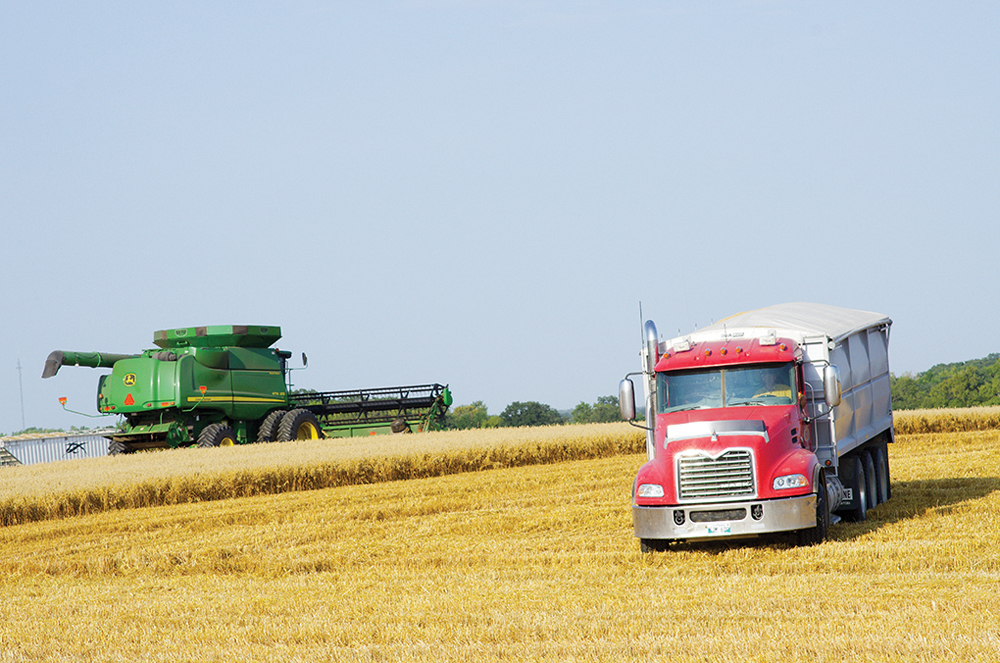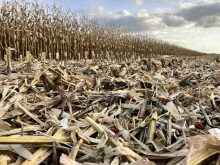Harvest progress in Manitoba is still behind the three-year norm.
According to the Sept. 1 provincial crop report, Manitoba’s cereal harvest is starting to wrap up. In winter cereals, winter wheat sat 95 per cent finished and fall rye topped off at 97 per cent complete.
Spring wheat, meanwhile, was about half done as of the first week of September.
This year’s barley harvest also shot up from the last week of August to the start of September. Just over 60 per cent of barley acres were in the bin, the province reported, much closer to the three-year average for the time of year than the week before. Producers could usually expect about 78 per cent of barley to be done. The prior week, the Aug. 25 crop report had shown barley lagged at 38 per cent done, compared to the average 65 per cent.
Why it matters: Farmers are making good progress on their cereals, but the echoes of a late spring are still being felt.
Quality also showed some good news. Barley was generally good malt quality with average yields or above in the southwest. Good quality was also reported in central Manitoba.
The report shows field-pea harvest at 89 per cent complete, 10 per cent behind the three-year average.
“As of this week we’re close to half done our harvest,” said Cory Elliot.

Elliot farms with his family near Pipestone, Man.
Any barley left standing on Elliot’s farm is ready for harvest, but is waiting on better weather after the region got some rain in the last weekend of August.
Any cereal crop left in a swath leads to concerns over cranes eating the crop, according to the farmer.
“A nice two-tenths of rain gave us a Sunday break,” Elliot said. “Some late-seeded canola needs pre-harvest weed control done because of frost and flea beetles. Other than that, all the canola is either swathed or pre-harvest weed control applications have been done.”
Swathed fields also struggled with wind in the first week of September, causing some swaths to pile in the field.
Canola
Now in the back half of the cereal harvest, attention is turning to canola.
The oilseed is significantly delayed this year, largely due to late seeding.
According to the Sept. 1 crop report, only seven per cent of canola harvest was done, although many areas reported swathing. Manitoba producers would normally expect to be almost half done their canola harvest.
“Looking at the three-year average, we’re a bit delayed,” Canola Council of Canada agronomist Justine Cornelsen said.

Cornelsen says there are a few disease issues going forward into the harvest, as some producers are seeing signs of verticillium stripe, a pathogen that thrived during the wet spring and following dry summer months.
The disease is fairly new to the Prairies, first identified in 2014 on a Manitoba-based research farm. In 2015 the Canadian Food Inspection Agency (CFIA) conducted a nationwide survey to determine the extensiveness of the pathogen and found it to be in multiple locations.
“Verticillium stripe is soil-borne, so it’s taken up by root(s) and then the stems dry down. It was so hot and dry through August, combined with a wet spring. That encouraged growth,” she said.
“The unfortunate thing is that we don’t have a lot of management practices as we don’t fully understand the pathogen or best management techniques yet,” she added.
Read Also

Glufosinate-resistant waterhemp found in U.S. Midwest
Kochia may also be on the road to Group 10 herbicide resistance, which would be a serious blow to Prairie farmers and canola growers, warns weed scientist.
Cornelsen ended by noting that, so far, the quality of Manitoba’s canola is looking promising.
“There are some yields lower than producers would have wanted due to the hot and dry summer, but the quality looks good,” she said.
She expects yield averages to increase as the canola harvest continues.
The provincial crop report noted that, “Nighttime temperatures are dropping quickly to single-digit lows, though daytime temperatures are still normal and helping the crops to dry down.”
Recent rains also did some good for unirrigated potato fields, the province noted. Potato heat units are sitting above their normal levels, and there has been no sign of late blight, although there have been some issues with bacterial stem rot and white mould.
The province reports all seed potato acres have been desiccated.
Progress on the province’s corn, sunflower, bean and flax harvests all sat at zero per cent as of Sept. 1.















